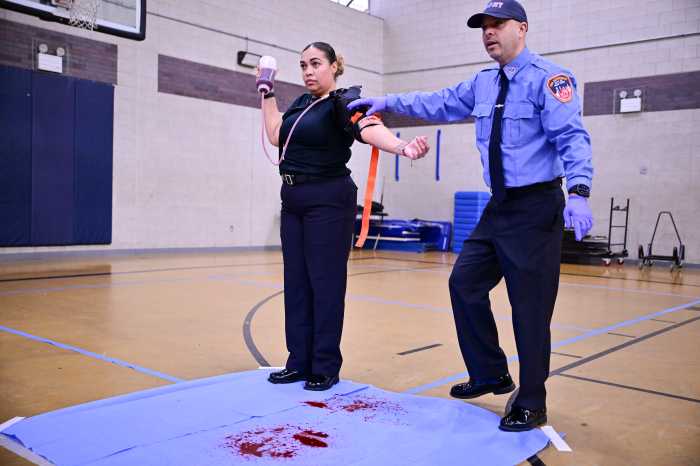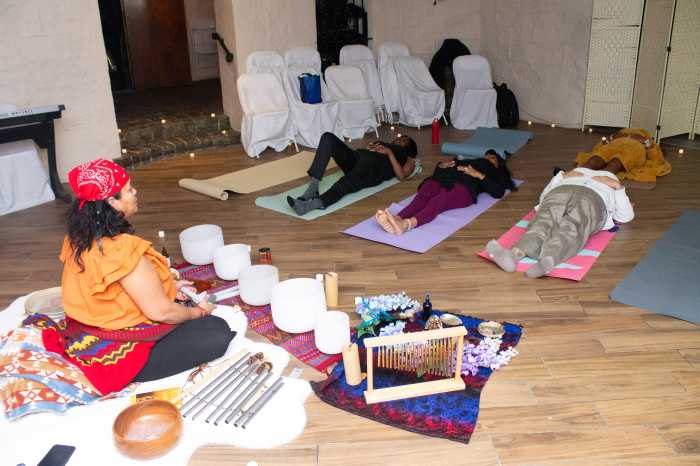After several years of expansion, the New York Film Festival has settled into a comfortable zone. There are a handful of Hollywood entries –– Robert Zemeckis’ “The Walk,” Danny Boyle’s “Steve Jobs,” Steven Spielberg’s “Bridge of Spies” –– sure to draw the attention of the mainstream media. One hopes they’ll stick around for the Chantal Akerman, Hou Hsiao-hsien, and Jia Zhang-ke films the festival has also programmed. With no Latin American or African films in the main slate (and only three films by women, although the sidebars offer a few more), the festival could be more diverse, though it offers a fair number of Asian films this year.
Todd Haynes’ “Carol” is the highest-profile LGBT-themed film offered up, but there are numerous other queer treats –– albeit mostly in the sidebars –– such as the retrospective devoted to gay avant-gardists Nathaniel Dorsky and Jerome Hiler, lesbian director Akerman’s “No Home Movie,” and husband-filmmaker couple Joaquim Pinto and Nuno Leonel’s autobiographical documentary “Fish Tail.”
Weerasethakul’s magic doesn’t fully fire; Maddin cranks it up further; Da Palma explains himself
Canadian director Guy Maddin’s “The Forbidden Room” takes all the unusual qualities of Maddin’s work and pushes them even further into excess. The ironic thing is that this ultra-Maddin film was actually made with a co-director, Evan Johnson. “The Forbidden Room” has a “Russian doll” structure of interlocking narrative, where a wrap-around section about bathing (written by poet John Ashberry) leads into a scene about life onboard a submarine. That, in turn, makes way for a narrative about a man’s attempt to ingratiate himself with a group of woodland thieves.
Formally, “The Forbidden Room” takes Maddin’s familiar influences –– the silent cinema of F. W. Murnau, avant-garde filmmakers like Jack Smith and the Kuchar brothers –– and cranks up what he borrowed from them to 11 on the dial. The editing and use of rear projection are very aggressive throughout. The film is constantly in motion, racing from one story to the next. If you’re a Maddin novice, “My Winnipeg” or “The Saddest Music in the World” might be a safer bet. “The Forbidden Room,” however, is one of his most accomplished films and it’s sure to delight his cult audience.
(Plays Sep. 28, 9 p.m.; Sep. 29, 9:30 p.m. at Walter Reade)
Thailand’s foremost gay Buddhist surrealist filmmaker, Apichatpong Weerasethakul returns with “Cemetery of Splendour,” which centers around a hospital ward housing comatose soldiers suffering from sleeping sickness. One volunteer (Jenjira Pongpas Widner) relies on crutches to walk because one of her legs is shorter than the other, and another (Jarinpattra Rueangram) is psychic and can see the soldiers’ dreams. When soldier Itt (Banlop Lomnoi) wakes up, he becomes friends with the women, sometimes using the psychic as a communication device.
As usual in Apichatpong’s world, “Cemetery of Splendour” is permeated by a gentle mysticism that comes to the fore most explicitly on a walk through a forest sculpture garden. However, many of its best ideas are only spoken about and not dramatized. I can’t exactly accuse the film of being drab –– in fact, its use of colored tubes in the hospital is often quite beautiful –– but I was disappointed that so much high strangeness is described rather than depicted.
“Cemetery of Splendour” also seems to struggle to say something about Thai history –– the men’s comas are said to give them the power to fight wars on behalf of ancient kings –– but without much knowledge of the culture, this remains frustratingly opaque. The echoes of Apichatpong’s hospital-set “Syndromes and a Century” don’t make this film look any more inspired.
(Plays Sep. 30, 9 p.m. at Alice Tully Hall; Oct. 1, 9 p.m. at Elinor Bunin Munroe)
As Hollywood movies grow increasingly bigger and more bombastic, the work of Korean director Hong Sang-soo gets more and more intimate and devoted to a set of small concerns: the lives of filmmakers and the people around them, told through complex structures.
“Right Now, Wrong Then” makes a possible lift from “Groundhog Day” in telling the same story twice with increasingly large variations. Filmmaker Ham Chun-su (Jung Jae-young) meets a young woman, Hee-jung, (Kim Min-hee), outside. Obviously attracted to her, he spends an evening getting drunk with her, but it goes no further than that. “Right Now, Wrong Then” charts minute aspects of heterosexual courtship and attempted seduction, but nothing much seems to be at stake.
Hong has often been compared to the directors of the French New Wave, particularly Eric Rohmer, but this feels closer to mumblecore. Hong directs with his customary reliance on the zoom lens, conveying the atmosphere of a college town in winter. In both sections, the set piece is the lengthy scene in which Ham and Hee-jung get drunk together, but the film doesn’t reveal much about the behavior of filmmakers not already showcased in Hong’s previous 16 films. An extremely prolific director, Hong is talented enough that I’m sure this is a momentary misfire.
(Plays Oct. 9, 9 p.m. at Walter Reade; Oct. 10, 3:30 p.m. at Elinor Bunin Munroe)
I’ve always been skeptical of the claims made by the late Pauline Kael and her followers that Brian de Palma is a great director, although I think he’s made a handful of major films. By enabling de Palma himself to speak in an uninterrupted flow, “De Palma” directors Noah Baumbach and Jake Paltrow allow him to make a case for his body of work, as well as admit the flaws of films like “Snake Eyes” and “Mission to Mars.” “De Palma” races through the director’s life and filmography, juxtaposing an interview (in which Baumbach and Paltrow’s voices are never heard) shot against a plain dark background with plentiful clips from the work of De Palma and other directors.
De Palma has been criticized for ripping off other filmmakers, especially Hitchcock, and for misogyny. He openly admits to the former –– in fact, “De Palma” opens with a clip from “Vertigo” –– but attributes feminist critiques of “Dressed to Kill” and “Body Double” to ‘80s fashion. As De Palma recounts his discovery of his voice and ability to launch a career, the film has a real joy. That largely fades after the ‘80s –– de Palma is honest about the probability that his glory days are behind him. Still, “De Palma” makes a great case for the merits of films like “Carrie” and “Blow Out” and leaves one wishing for a de Palma retro.
(Plays Sep. 30, 6 p.m. at Alice Tully Hall)
53RD NEW YORK FILM FESTIVAL | Sep. 25-Oct. 11 | Various venues at Lincoln Center | Complete schedule, tickets at filmlinc.com





















